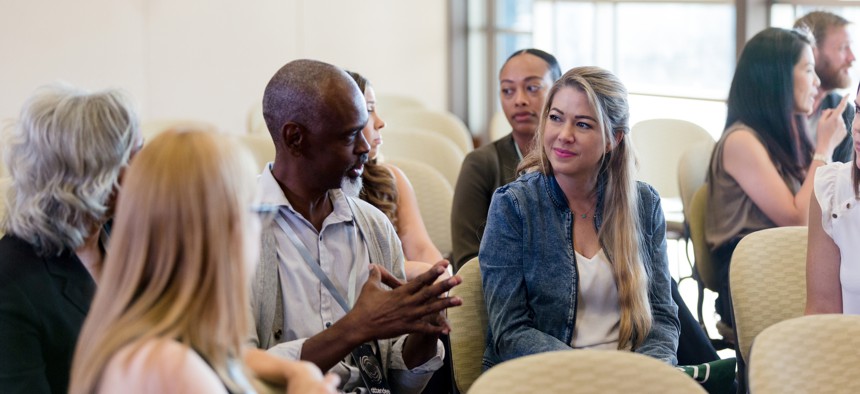Why community digital equity discussions should be in person

SDI Productions/Getty Images
More than 50 town halls addressing accessibility, affordability, devices and digital skills will help Iowa’s Department of Management ensure that all residents can participate in the digital economy.
Iowa’s Department of Management (DOM) is kicking off a series of 50-plus town hall-style meetings to learn directly from residents what broadband and digital services they need.
“The purpose of this is to not pretend that we have all the good ideas here, but to really make sure that this is a community effort,” said Matt Behrens, the state’s chief information officer.
Driving the effort are the Infrastructure Investment and Jobs Act (IIJA) and the Broadband Equity Access and Deployment (BEAD) Program that provide funding to states and territories for grants to be used for high-speed internet deployment that will close accessibility gaps in unserved and underserved areas.
The in-person meetings, which DOM announced March 6, started March 14 and will run through late May. They will cover four topic areas: accessibility, affordability, digital devices and digital skills.
“It’s a way to facilitate discussion and catalyze some understanding around this concept” of equity, Behrens said. “The idea with that is to really think bigger about what we need to be doing collectively to help ensure that everyone has access to educational opportunities, civic and social opportunities, telehealth, [and can] participate in the digital economy.”
One reason the meetings are not available virtually is to emphasize local, in-person participation, he added. “We want to be out in the communities, we want to visit with people and we don’t want to make any assumptions that they’ll have the technology or the connectivity in order to participate virtually.”
Those who attend will have a chance to break into groups to discuss the four topic areas. Although Behrens said there is no target number of attendees, the more the better. “The more folks that we have attend, the more robust the discussion will be, the more ideas that we’ll get,” he said.
His office will synthesize the feedback from the meetings—55 have been scheduled so far—for use in plans related to IIJA and BEAD. Additionally, it could inform more in-depth research into the topics through surveys and focus groups.
This is the first time the state has used this type of approach to solicit resident feedback, but it may not be the last.
“I run the central IT organization for the state, [but] it’s not my organization, it belongs to Iowans,” Behrens said. “We really want to encourage participation of this nature to help guide what we do here, because ultimately, our job is to serve Iowans,” he said. “One of the ways that we do that is by understanding where Iowans are at, what they need, and making sure that there are opportunities for them on a continuous basis to provide us feedback on how we’re doing.”
Iowa has been working to improve broadband access since 2018. Its Empower Rural Iowa Broadband Grant Program has issued seven funding opportunities for broadband expansion and awarded $350 million to provide new broadband service to unserved and underserved locations. On completion, these projects will result in about $700 million in new broadband investment, according to a March 1 announcement.
That day, DOM also opened the month-long application acceptance window for its Broadband Intervention Zones Invitation to Qualify program, which is “a way for communities to self-identify that they have a critical need for broadband investment,” Behrens said. “The idea there is to gather information directly from communities about where they believe broadband funding should go. So, instead of having a grant program where providers can pick the areas that they want to pick, we want a program for our future that relies upon community input and data from our communities to help guide some of those decisions.”
The benefits of a better-connected constituency are many, but Behrens said he sees it as an opportunity for a positive snowball effect: “If you can use the broadband connectivity that will become available to you or the digital equipment or the skills to have a closer connection with your government and to receive services more rapidly and efficiently, that seems like it’s good for everybody, so we’re excited about that.”
Stephanie Kanowitz is a freelance writer based in northern Virginia.
NEXT STORY: 3 applications driving 5G in public safety





